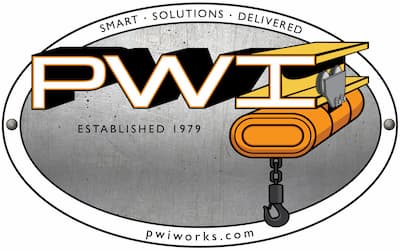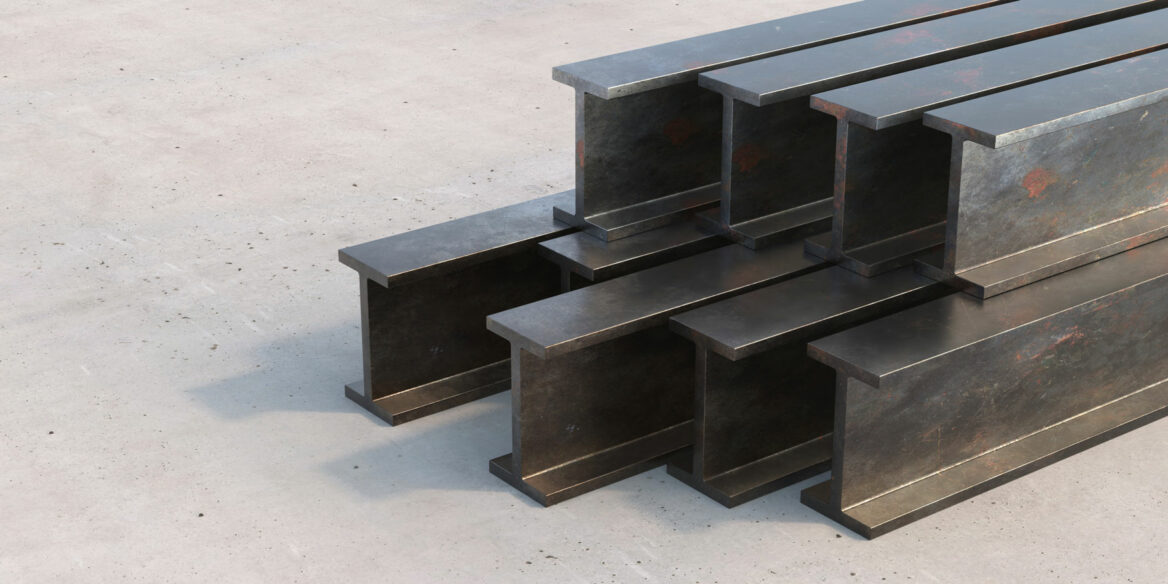The term I-beam refers to the end view of a structural member that forms the capital letter “I”. It would also look like the capital letter H. It actually refers to different types of structural steel members including H-beam, W-beam, and S-beam. In this article, we will explain the precise differences so you can choose the right beam for your construction or manufacturing needs.
What is an I-beam?
That’s a bit of a trick question.
I-beams are, in fact, just a generally used term to describe a structural steel beam (or member) with a shape similar to a capitalized I or capitalized H on its side. You may also hear them described as a universal beam.
The term I-beam is often used as a broad term when referring to three main types of structural steel members:
- H-Beam
- W-Beam
- S-Beam
In this article, we are going to explain exactly what the difference is between these three types of structural steel beams and help you identify what is the best option for your next construction project.
I-Beam, W-Beam, H-Beam, and S-Beam: What’s the Difference?
Their shape is formed from three components: two horizontal flanges and one vertical web. The relation between the flange and web width and thickness provides different structural properties.
So, how can you tell the difference between an I-beam, a W-beam, an H-beam, and an S-beam?
I-Beam
A classic I-beam shape describes a structural beam with narrow flanges compared to the web length. The downside of an I-beam is that the narrow flanges make it less suitable for use as a column because there is a higher risk of buckling. They also lack torsional strength.
W-Beam
Wide flange beams (or W-beams) have a wider flange that is closer in width to the height of the web. The result is a cross-section that more resembles an uppercase H than an I. Unlike an I-beam, the flanges are a uniform shape and have a similar thickness web and flange.
This design enables a W-beam to distribute loads over a wider area making them suitable for use as a beam or column in any size of construction including large buildings and bridges.
W-beams, like I-beams, are made by drawing molten steel through a sequence of dies and rollers that form the shape. This shape results in a slightly chamfered connection between the flange and web which helps increase the beam’s uniform strength and multi-directional force resistance.
H-Beam
This type of beam is very similar to the W-beam in that it has wide flanges that create a cross-section resembling an H. The difference is how they are manufactured.
H-beams are normally built up from three lengths of steel—two flanges and a web—that are welded together along the junction. The welding process is done either manually or by rolling the three lengths of steel through a die that holds them in place and a weld is made across the entire length of the beam.
Welded beams are considered to be up to 20% stronger than a drawn beam.
S-Beam
The American Standard S-beam is a structural steel beam that is very similar to an I-beam with one big difference. The flanges are tapered—a 1:10 inclination—with a thicker cross-section towards the center where the flange (horizontal) meets the web (vertical). This makes for a lightweight member that has high load bearing capacity.
They are very resistant to bending and shear loads which is why they are often used in crane manufacture. The tapered flange provides higher wheel load capabilities for the trolley meaning that it can lift heavier loads than a hoist built using an I-beam.
Disclaimer
One important note is that some manufacturers in the steel industry may refer to S-beams as I-beams and vice versa. This is due to misclassifications of each beam based on whether they have a tapered flange or not. H-beams and W-beams are often also used interchangeably.
If in doubt, request a cross-sectional drawing of the beam that you want to purchase so that you can confirm whether it uses a tapered flange or not. This will influence whether some uses of structural steel beams such as whether they can be bolted together and what type of trolley they require in hoist applications.
How Are Structural Members Used?
Their distinctive “I” shape means that these structural beams can withstand various types of load in different directions making them highly versatile. They are used extensively in the metal building industry on any size of structure from a single garage to hospitals, high-rises, and even bridges.
The most common uses of I-beams are horizontal beams to support a building and roof structure and vertical columns. Structural members are essential to a building’s composition because they bear the building’s entire weight much like a skeleton.
Lateral beams are often installed in a grid-like structure to spread the load and transfer it to vertical members. These are used as support columns that transfer compressive loads to the building foundations.
The skeletal structure of a building must be able to withstand various forces, including tension, compression, bending, shear, and torsion. This is to help protect the building against harsh weather or environmental conditions such as high winds, heavy rain, and earthquakes.
The configuration of structural members means that they can protect against the forces acting upon a building in all directions.
How Does an I-Beam Work?
The dimensions of the flange and web are what influence how resilient the structural member is to different forces. A building’s structure is exposed to several forces that vary in frequency and intensity. The skeletal structure must be resistant to all of them to avoid potentially fatal and costly consequences.
There are five main forces a structural beam must resist:
- Bending: Tensile and compressive stress combine to create a bending moment. Failure from bending is caused when the tensile and compressive forces exceed the yield limit of a beam.
- Buckling: When a sudden change in shape due to torsional stress causes the beam to deform. This is more common when oriented as a column. Flanges are an important consideration.
- Deflection: Deflection is the amount a structural beam will bow or bend when a load is applied to the length of it. The amount of deflection can be minimized by using an adequate thickness of steel for the structural beam.
- Tension: Beams are subject to pulling and stretching forces. Choosing the right web thickness can help mitigate the chance of rippling or buckling.
- Vibration: The use of compressors, pumps, and engines on-site causes vibration. To counteract this dynamic force, stiffer and higher-mass beams should be used.
The non-uniform cross-section of a structural beam is designed to deflect or bend under excessive load as opposed to buckling.
I-Beams in a Production Setting
Steel beams are extensively used in production for manufacturing hoists. The multi-directional force resilience provides a great benefit for hoisting loads and the unique shape contributes to the strength-to-weight ratio of the hoist.
Depending on the type of crane, different steel beams are used. The load capacity of the crane, as well as how the beam is supported will determine the most suitable type of beam.
For example, an overhead crane that is supported by the building structure at both ends will use a single or double I-beam, depending on the load capacity and height clearance. A cantilever crane—that is only supported from one end—is manufactured using an S-beam because the tapered flanges optimize the load capabilities without requiring additional support. (PWI does not use S-Beams except for repairs. We would use a W-beam in building a new product)
The shape of a flange, whether tapered or not, enables the use of a trolley that easily attaches to the inside edge of the flange. The side plates of the trolley have wheels with lubricated bearings that bear on the beam flange.
Trolleys can be manually operated but these are limited to around 5 tons because the effort to move them becomes too great for 1 person. For ease of use and more accurate placement, sites would use a geared or electric beam trolley that allows for ease of motion and precise placement of the load.
In addition to forming the structure of a crane, structural beams can also function as below-the-hook devices such as spreader beams. These can be configured in single beams or H-shapes to accommodate different loads.
Structural Beams in a Construction Setting
Universal beams are used in almost all large structural construction projects because of their load capacity and resistance to multi-directional loading. Warehouses and large buildings rely on steel structural beams to create a skeleton with structural integrity that is not reliant on additional support.
The I or H shape of a universal beam also has excellent strength-to-weight properties meaning that less material is needed to support a load. It also inherently uses less material when manufactured helping to keep construction costs down.
Thanks to their wide range of applications, universal beams are readily available in various sizes. In short, this means that wherever your construction site is, you will likely be able to source additional materials from local distributors if required.
I-Beam Sizes and Classification
In the United States, steel I-beams are categorized based on three factors:
- The grade of steel – A36, A572, A588, A992
- The shape type – S, W, or H
- The size – depth, flange thickness, flange width, and web thickness
Structural Steel Grades
The grades of steel are determined by its yield strength and ultimate tensile strength. Yield strength means the minimum stress required to deform a material, and tensile strength is the maximum stress a material can withstand before breaking.
- A36: 36,000 psi
- A572: Varies between 42,000 and 60,000 psi. 50,000 psi is the most common.
- A588: Can be used as an alternative to A572.
- A992: 50,000 – 65,000 psi
Most steel beams are manufactured using two types of structural steel.
Carbon Steel is mainly composed of iron with up to 2% carbon content. Higher levels of carbon help to improve yield strength but reduce ductility. Low-carbon steels like A36 contain less than 0.3% carbon meaning it is more ductile or flexible. This makes it well suited for large-scale construction like bridges or tall steel buildings where the structure needs to resist movements in the ground as well as deflect wind.
High strength low alloy steel needs to withstand mechanical stress and have high corrosion resistance for use in high-risk and demanding environments. It is composed of up to 2% magnesium and trace elements like chromium, nickel, niobium, nitrogen, and titanium. Common examples of high strength low alloy steels include A572, A588, and A992 with the latter having the highest corrosion resistance.
Common I-Beam Sizes
As you might expect, some dimensions of structural beams are used more frequently than others. This is mainly for their optimized strength-to-weight ratios and adaptability for different types of structures. It is common for W-beams to be used extensively because they are more easily bolted together compared to a relatively narrow I-beam.
A W-8×31 beam has a very square cross-section measuring around 8” square. It is frequently used as columns in the upright position and is rarely used horizontally as a beam. Other commonly used beams include:


Depending on where you purchase your structural steel beams, the distributor is likely to use a combination of these different measures and classifications.
If you have gotten this far in the article, you should be well-equipped to make the correct selection based on your construction or manufacturing requirements. But if you need any assistance, the expert team at PWI is here to help.


![New Construction vs Mezzanine [PDF]](https://pwiworks.com/wp-content/uploads/new-construction-vs-mezzanine-pdf-464x600.jpg)